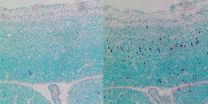A key role for CEP63 in brain development and fertility discovered
Researchers at IRB Barcelona study CEP63, a gene that is mutated in Seckel syndrome, a rare disease that causes microcephaly and growth defects
2015-07-07
(Press-News.org) Today in Nature Communications, scientists at the Institute for Research in Biomedicine (IRB Barcelona) provide molecular details about Seckel Syndrome, a rare disease that causes microcephaly, or small brain, and growth delays. A joint study conducted by Travis Stracker and Jens Lüders indicates that the protein CEP63 plays a key role during brain development as it is involved in the correct division of stem cells in this organ. Furthermore, the researchers have discovered that CEP63 is associated with sperm production--an unknown function until now.
Rescuing microcephaly in mice
There are no treatment options for microcephaly to date. This defect in brain growth is present in several neurodevelopmental diseases, including Seckel Syndrome. "There are diagnostic tests for some of these kinds of pathologies that can be performed during pregnancy, but other than early detection, the expectant parents are limited to two choices, either to abort or to continue with the pregnancy, being fully aware of the outcome," explains the North American scientist Travis Stracker. "Our research paves the way to explore therapeutic approaches for microcephaly involving the inhibition of the protein p53," says the head of the Genomic Instability and Cancer Lab at IRB Barcelona.
The scientists describe that this protein triggers the death of brain stem cells. This occurs because cells without CEP63 have delayed cell division, leading them to enter programmed cell death through p53. "Cell death due to mutations in CEP63 is the main cause of the brain defects. When we prevent cell death by removing p53 from developing embryos, the brain develops to its normal size," explains Jens Lüders, head of the Microtubule Organization Lab.
This finding paves the way to study whether p53 inhibitors could provide the basis of a future treatment to prevent microcephaly. "It is early to say that we have a treatment proposal for humans because we are in the first stage of discovery. Also, a normal sized brain does not imply a functional brain," warn the researchers. "Our next goal is to test the p53 inhibitors currently available in the same mouse models and to characterise and analyse the long-term effects. Furthermore, p53 inhibition could be harmful because this gene has many functions in correct embryonic development," they add.
Infertility
The study also revealed that CEP63 is related to fertility in male mice. The researchers have discovered that this protein is involved in sperm production and, when absent, mice show severe infertility. "We know that CEP63 depletion leads to problems during meiosis, a specialized type of cell division that is required for male germ cells to produce sperm," explains Stracker. "It is an interesting finding because in many cases fertility problems are not widely understood and this study provides a different molecular perspective to examine," says Lüders.
INFORMATION:
The study has been financed by the "Plan Nacional" of the Ministry of Economy and Competitiveness and by the European Union programme Marie Curie Actions, through a postdoctoral grant awarded to Marko Marjanovi?, first author of the study.
Reference article:
CEP63 deficiency promotes p53 dependent microcephaly and reveals a role for the centrosome in meiotic recombination
Marko Marjanovi?, Carlos Sánchez-Huertas, Berta Terré, Rocío Gómez, Jan Frederik Scheel, Sarai Pacheco, Philip A. Knobel, Ana Martínez-Marchal, Suvi Aivio, Lluis Palenzuela, Uwe Wolfrum, Peter J. McKinnon, José A. Suja, Ignasi Roig, Vincenzo Costanzo, Jens Lüders, and Travis H. Stracker
Nature Communications (July 2015): DOI: 10.1038/ncomms8676
About IRB Barcelona
Founded in 2005 by the Government of Catalonia and the University of Barcelona, the Institute for Research in Biomedicine (IRB Barcelona) is "Severo Ochoa Centre of Excellence", since 2011. The 23 groups and seven scientific platforms are devoted to basic and applied research with the common goal of conducting multidisciplinary projects that address important biomedical problems affecting our society, with special emphasis on cancer, metastasis, Alzheimer, diabetes and rare diseases. The institute is home to more than 400 employees from 36 countries. IRB Barcelona's ultimate objective is to translate research results to the clinic and has already established three biotechnology spin-off companies to this end. This year the IRB Barcelona celebrates its tenth anniversary.
http://www.irbbarcelona.org /@IRBBarcelona / http://www.facebook.com/irbbarcelona
ELSE PRESS RELEASES FROM THIS DATE:
2015-07-07
This news release is available in Spanish. Mikel Zubizarreta, a member of the UPV/EHU's IT 781-13 group, highlights the advantages of timber in building works: "Although it is not as tough as other materials used in structures, it is a better insulator, in other words, it is more energy-efficient and less dense so the structure weighs less. On the other hand, timber is a renewable material -trees are planted and grown and forests are a CO2 sink- and is abundant in the Basque Country (nearly 55% of its surface area consists of forests)."
Yet timber is used much less ...
2015-07-07
PHILADELPHIA - Many people believe that phase I trials with healthy volunteers are very risky and because they pose risks with no benefits, unethical. But how risky are such trials? Less than 1% of 11,000 healthy volunteers who participated in 394 phase I trials for new drugs experienced serious complications, according to a new meta-analysis of participants in non-cancer, phase I medication trials. In addition, none of the volunteers died or suffered persistent disabilities linked to the experimental drugs. In the largest study of its kind, researchers found only 34 (0.31%) ...
2015-07-07
Washington, D.C. - July 6, 2015 - Those bacteria that require iron walk a tightrope. Iron is essential for their growth, but too much iron can damage DNA and enzymes through oxidation. Therefore, bacteria have machinery to maintain their intracellular iron within a range that is healthy for them. Now Theresa D. Ho, PhD, and Craig D. Ellermeier, PhD shed new light on how the pathogen, Clostridium difficile, which is the most common cause of hospital-acquired infectious diarrhea, regulates iron. The research is published online ahead of print July 6 in the Journal of Bacteriology, ...
2015-07-07
While nitrous oxide gas has been used recreationally and medically for more than 200 years - originally for its euphoric and then for its pain relieving and anesthetic properties - the mechanism behind its effects on the brain has been poorly understood. A report from investigators at Massachusetts General Hospital (MGH) finds that the EEG patterns of patients receiving high doses of nitrous oxide differ significantly from those of the same patients when they had received ether-based inhaled anesthetics earlier in the procedures, findings that - along with suggesting how ...
2015-07-07
WASHINGTON, July 7, 2015 - In 1962, an underground fire started in the coal-mining town of Centralia, Pennsylvania. Fifty-three years later, that fire still burns. In this week's episode of Reactions, we explain the history and science behind the Centralia mine fire. Does anyone still live there? How could the fire keep burning for so long, and why hasn't it been extinguished? From a chemical standpoint, what is fire, anyway? It's all answered in our latest video: https://youtu.be/fsgqy5FYP2c.INFORMATION:
Subscribe to the series at http://bit.ly/ACSReactions, and follow ...
2015-07-07
HONOLULU - Aspirin may inhibit the growth of mesothelioma, an aggressive and deadly asbestos-related cancer, University of Hawai'i Cancer Center researchers have found.
The finding could eventually give doctors and patients a potential new tool to fight against this devastating disease, which kills about 3,200 people a year nationwide, and advance knowledge of how to fight other cancers.
The study published in Cell Death and Disease showed that aspirin slows down the growth of mesothelioma by blocking the carcinogenic effects of the inflammatory molecule, High-Mobility ...
2015-07-07
Researchers have developed a new design for a cloaking device that overcomes some of the limitations of existing "invisibility cloaks." In a new study, electrical engineers at the University of California, San Diego have designed a cloaking device that is both thin and does not alter the brightness of light around a hidden object. The technology behind this cloak will have more applications than invisibility, such as concentrating solar energy and increasing signal speed in optical communications.
"Invisibility may seem like magic at first, but its underlying concepts ...
2015-07-07
University of Adelaide researchers are developing a laser system for fast, non-invasive, onsite breath analysis for disease, potentially enabling screening for a range of diseases including diabetes, infections and various cancers in the future.
The researchers have developed an instrument they equate to an "optical dog's nose" which uses a special laser to measure the molecular content of a sample of gas.
"Rather than sniffing out a variety of smells as a dog would, the laser system uses light to "sense" the range of molecules that are present in the sample," says ...
2015-07-07
KUNMING, 7 July 2015 - Increasing amounts of environmentally valuable and protected land are being cleared for rubber plantations that are economically unsustainable, new research suggests. More widespread monitoring is vital to design policy that protects livelihoods and environments.
The research was recently published in Global Environmental Change and constitutes a joint effort by scientists at the World Agroforestry Centre (ICRAF) East and Central Asia office, the Chinese Academy of Sciences, the Royal Botanic Garden Edinburgh, the University of Singapore and the ...
2015-07-07
A piece of deep frozen ice and electronic gadgets may seem to have little connection (except that they are both 'cool' to have on you), but ice could now play a role in opening a new era in the electronic industry where conducting polymers, simply put plastics with electrical properties, are in great demand for practical applications.
Chemists at Pohang University of Science and Technology (POSTECH), Korea, have discovered an innovative method to form two-dimensional polyaniline (PANI) nanosheets using ice as a hard template. The product, called PANI-ICE, is reported ...
LAST 30 PRESS RELEASES:
[Press-News.org] A key role for CEP63 in brain development and fertility discovered
Researchers at IRB Barcelona study CEP63, a gene that is mutated in Seckel syndrome, a rare disease that causes microcephaly and growth defects





